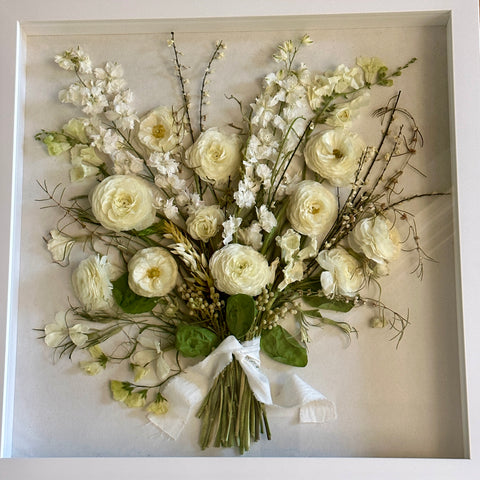5 Tips On What Wedding Flowers You Should Consider, If You Want To Preserve Them Afterwards
If you're determined to preserve your bouquet but uncertain about which flowers will shine on your special day and retain their charm when dried, fear not. I'm here to provide you with essential insights on what factors to consider and key points to discuss with your florist.
- Pay attention to colour
The number one, most important tip is consider colour! While the allure of classic white blooms paired with abundant foliage hold immense appeal, they aren't the most conducive to preservation. While preserving them is still possible, introducing a subtle hint of colour can enhance the dried flowers when showcased in a frame. If you're inclined towards tradition, consider incorporating delicate accents of peach or pink tones, as they typically retain their hues better than white flowers, which often transition to a cream or ivory shade.
Just as interior designers understand the impact of a well-placed burst of colour in a neutral space, so too can vibrant wedding bouquets against the backdrop of a white or ivory bridal gown enhance the overall aesthetic of your special day. Beyond bouquets, consider the versatility of coloured wedding flowers—they can adorn not only bouquets but also your wedding cake, accent doorways, and embellish chair backs, adding delightful touches of colour and charm throughout your celebration.
We absolutely love working with colourful bouquets and find they yield the best results when preserved.


- Types of flowers to consider
Considering the season and time of year will influence the types of flowers available for your bouquet. Tip #2 for preservation revolves around selecting sturdier flowers with a solid structure, such as roses, dahlias, orchids, and hydrangeas, as they dry exceptionally well and maintain their shape. Conversely, less dense flowers or those with numerous petals, like freesias and chrysanthemums, typically do not dry as effectively unless they are very fresh or close to bud stage to preserve their form. White Lisianthus, for instance, tends to take on an unappealing yellow-brown hue when dried, deterring us from including them in our preservation process. While stunning when fresh, we opt to use only the buds of White Lisianthus for texture, avoiding the undesirable colour change during drying.
- Include foliage if it suits your theme
Fresh foliage not only enhances the beauty of blooms by framing them but also plays a vital role in protecting the flowers. Similarly, in a preserved frame, foliage offers the same benefits. Our intense drying process using silica sand, can render the blooms fragile and almost papery, thus utilising the foliage becomes crucial for protection. In addition it offers texture, contrast, and shape to most designs. However, not all foliage is equal —some may turn brown over time. We particularly favour eucalyptus, white/green limonium, and can also work with magnolia, ruscus, hydrangea, and rose leaves. Conversely, lambs ear isn't ideal for preservation as it tends to retain sand particles, impacting the final result.
- Consider the smaller details
We suggest requesting your florist to incorporate various blooms for added texture. Your framed bouquet will serve as a captivating piece of art adorning your walls, where attention to even the smallest details will shine through as you admire it. Consider including flowers like Baby’s Breath, Limonium, Queen Anne's Lace, buds, miniature daisies, wheat, grasses, sweet pea vines, and similar to infuse intricate detail into your frame. Furthermore, these blooms will also enhance the beauty of your fresh bouquet.


- Tell your florist that you’re preserving your bouquet
If possible, inform your florist in advance about your plans for your flowers after the wedding. This communication may lead them to incorporate various elements into your bouquet, similar to the list I've provided above. While they should already be selecting the best and freshest blooms, knowing your desire for a longer-lasting display might prompt them to choose something different. Moreover, they may offer assistance in maintaining the freshness and vibrancy of your flowers for an extended period.
